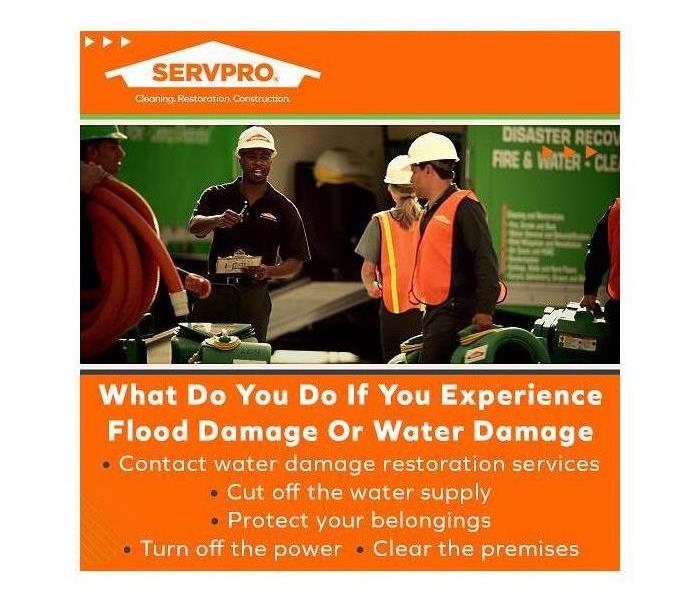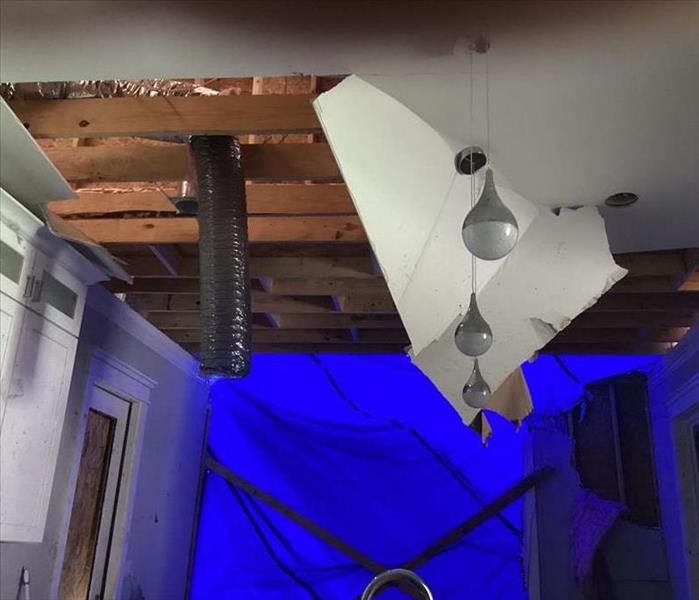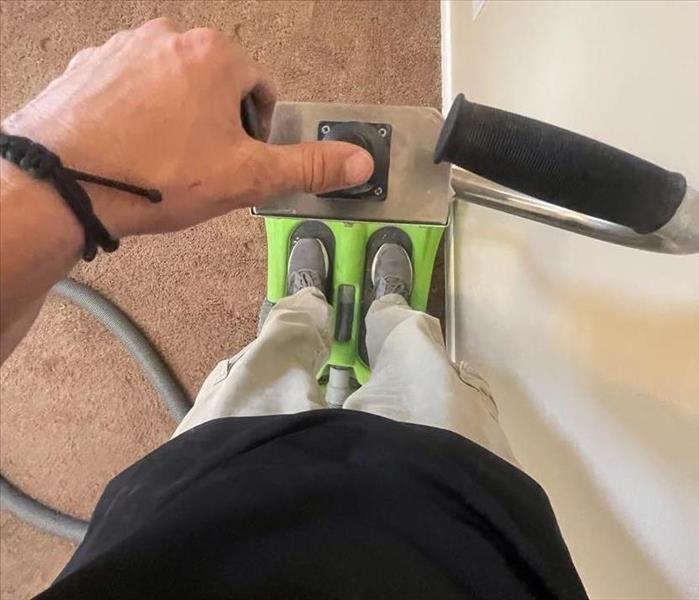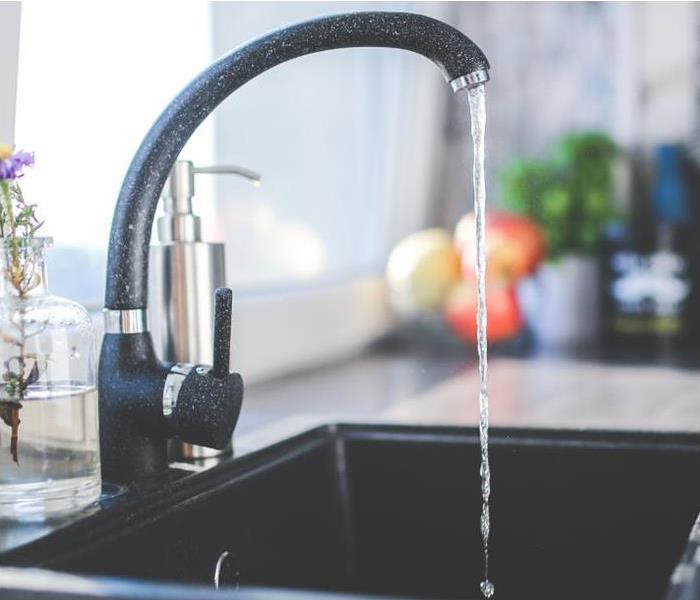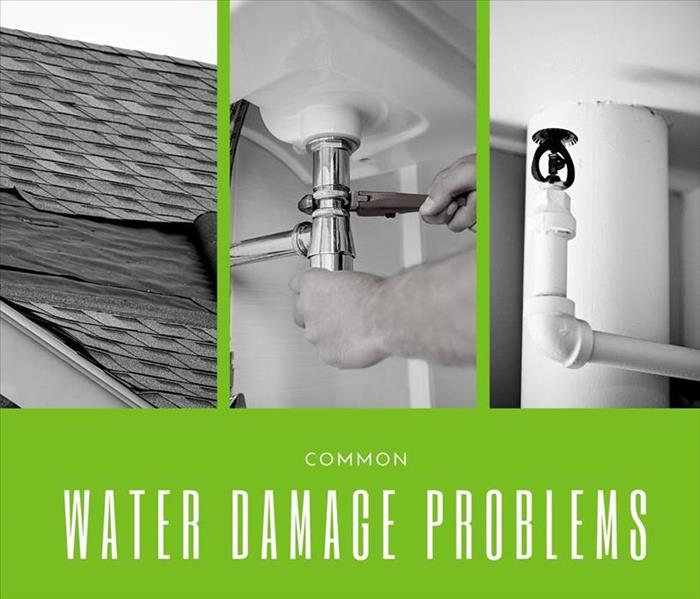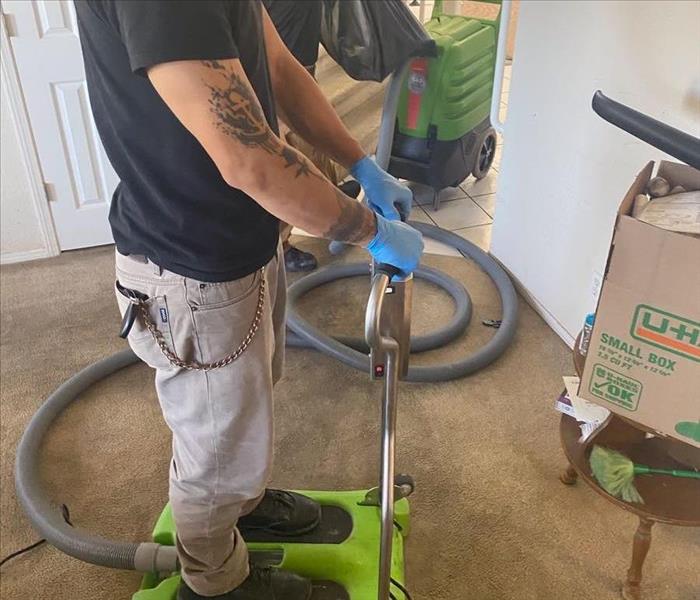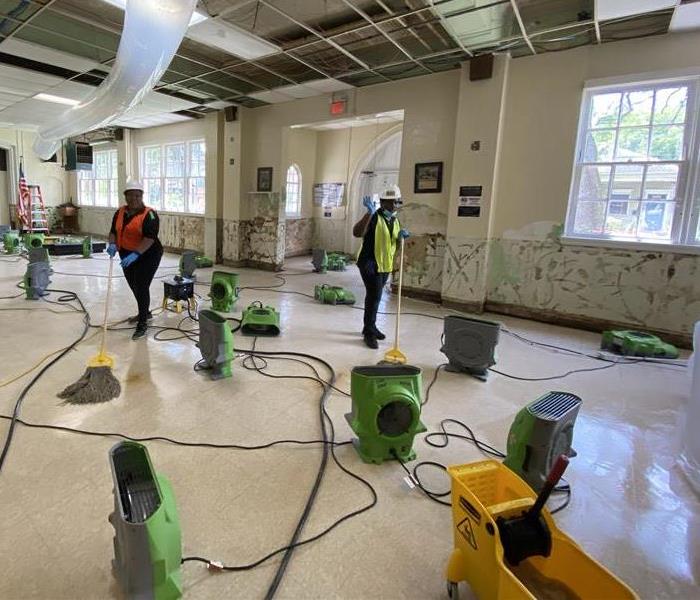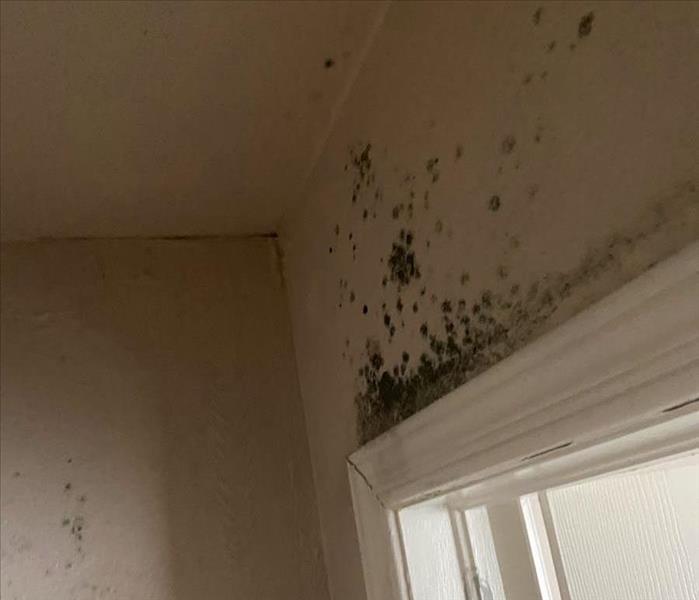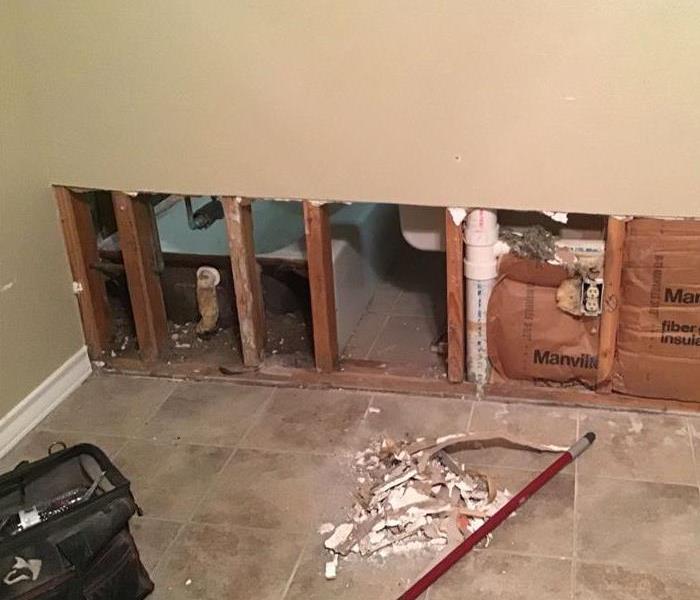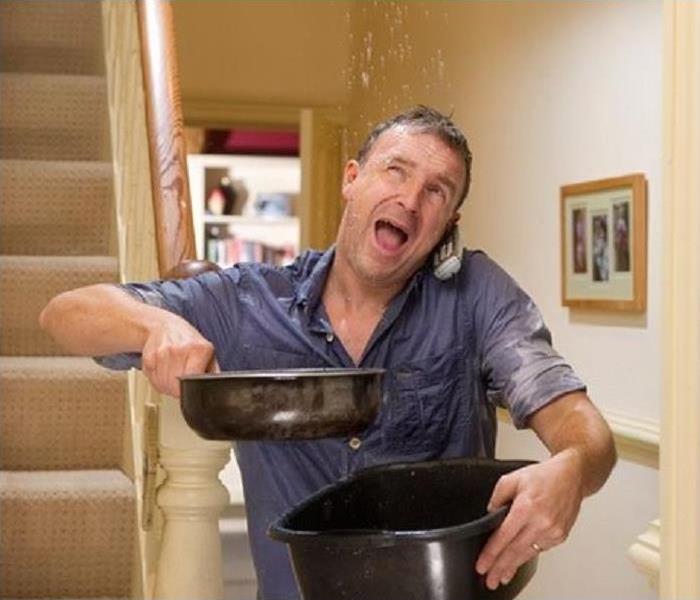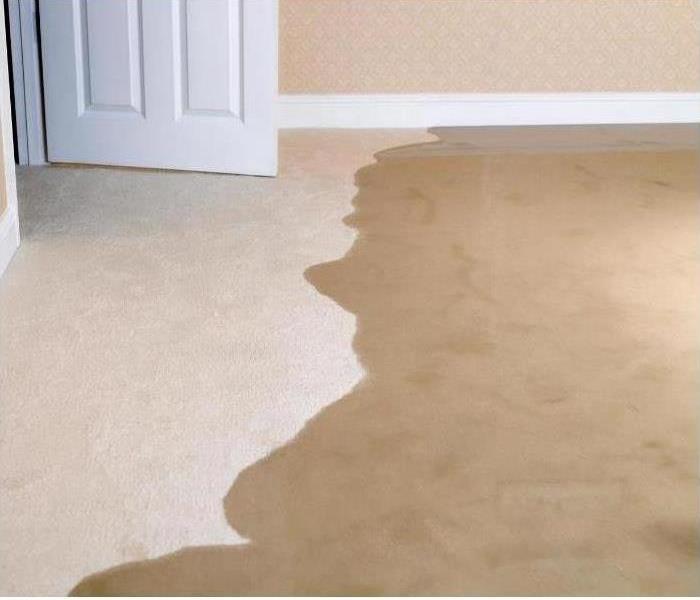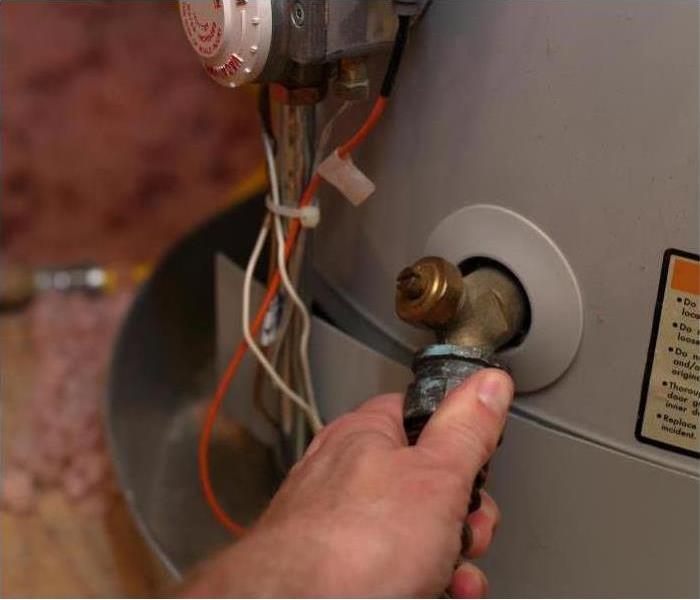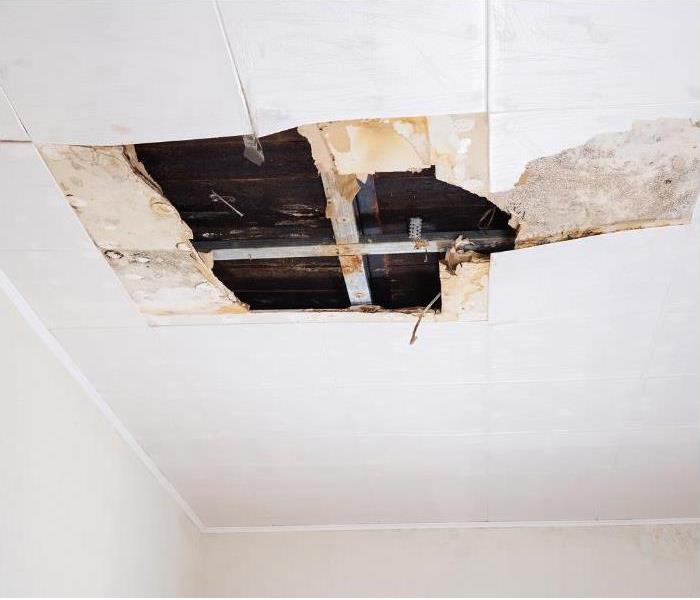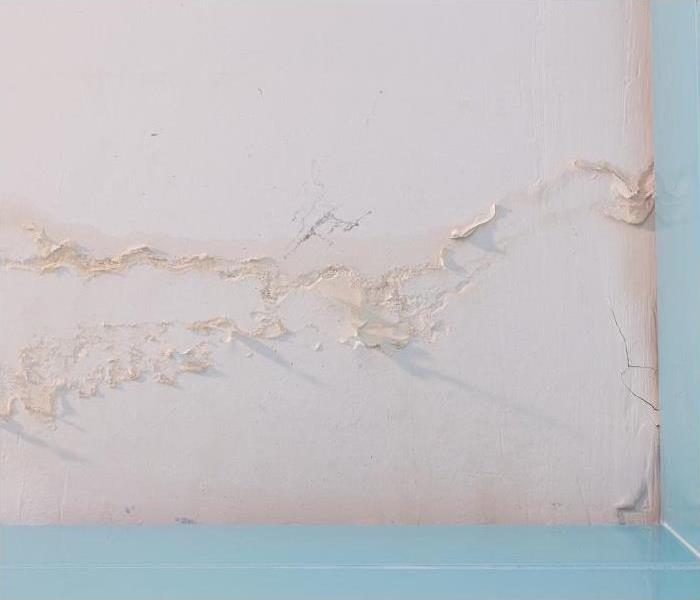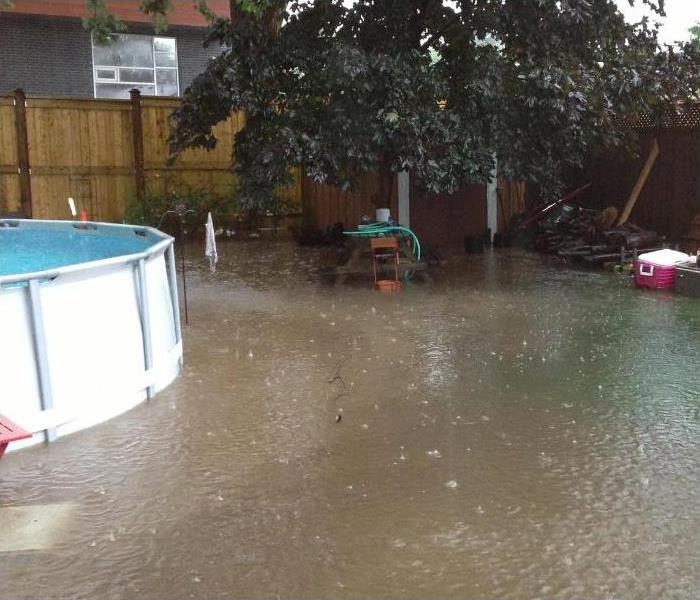Recent Water Damage Posts
Inundation and its aftermath: The immediate impact that leaves no corner untouched.
1/27/2024 (Permalink)
 The SERVPRO Van on the way to a job with "Faster to Any Disaster" on the back of it.
The SERVPRO Van on the way to a job with "Faster to Any Disaster" on the back of it.
When a storm unleashes its full fury, the result is a powerful inundation that spares no corner of your West El Paso home. The rapid influx of water infiltrates every nook and cranny, leaving behind a trail of destruction. Water enters every crevice from the ground floor to the upper levels, leaving no area untouched.
As the water invades your living spaces, furniture, carpets, and belongings are soaked, bearing witness to the storm's force. Floors become slippery, making movement treacherous. Electrical systems are compromised, raising safety concerns. The immediate aftermath can leave you overwhelmed and confused.
Visible damage is only part of the story. Water seeps into hidden recesses and beneath floorboards, causing additional harm. Structural elements may weaken over time. Immediate action is crucial to prevent further deterioration and minimize long-term consequences. SERVPRO of West El Paso recognizes the urgency of addressing the immediate impact of inundation. Our experienced team arrives swiftly, equipped with the tools and expertise to extract standing water and begin drying.
Call the experts at SERVPRO today and let us handle all of your water and storm remediation needs for your home or office.
The deluge begins: Unleashing the relentless power of heavy rainfall to your West El Paso home.
1/27/2024 (Permalink)
 A SERVPRO van on the way to a new job site with the words "Fast to Any Disaster" written on the back!
A SERVPRO van on the way to a new job site with the words "Fast to Any Disaster" written on the back!
When the heavens open up and heavy rain pours down, it begins a deluge that unleashes the relentless power of nature. West El Paso homes, usually safe and secure, become vulnerable to the onslaught of water. The sheer force and volume of the rainfall can quickly overwhelm drainage systems, saturating the ground and infiltrating every possible opening in your home.
As the rain intensifies, the risk of water damage increases exponentially. Roofs, windows, and doors become the front line, facing the unyielding assault. Even the smallest cracks or compromised seals can allow water to seep in, finding its way into your sanctuary. Unrelenting in its determination, the water creeps through walls, ceilings, and floors, wreaking havoc in its path.
The immediate consequences of heavy rainfall are evident: standing water accumulating in basements, flooded rooms, and dampened carpets. The impact is not limited to visible areas alone; hidden moisture pockets can develop within walls, inviting mold growth and compromising structural integrity. The longer the water remains stagnant, the greater the risk of extensive damage and costly repairs.
SERVPRO of West El Paso is here to help you with all of your water and storm damage. Contact the professionals today.
Here Are 8 Reasons Why Your Toilets Are Leaking!
10/27/2022 (Permalink)
We have all walked past the bathroom and hear the water running in the back of the toilet and either jiggled the handle or lifted the back to see if anything was obviously wrong. Water leaking around your toilet can soak into the floor and beyond. It is important to take action if you see a puddle of water around the toilet bowl or even hear a slow drip somewhere behind the wall.
1. Tank is Cracked
While tanks and the bowls are pretty durable, they can get cracks. These often start with a small, hairline crack, but can get bigger. Toilets may get shifted or jarred and can get cracked in the back where you won’t notice them.
2. Worn Washers
There are two large bolts that keep the tank attached to the bowl, and two more that keep the toilet bolted to the floor. If the bolts or washers get stripped, rusted out, break, or wear out, they won’t be able to hold it all together.
3. Pipe Corrosion
There could be corrosion in your pipes because of age, impurities in the water, or heavy metals in your water. Rust will develop in the metallic portions of the toilet because of this corrosion.
Pipe corrosion can often cause a lot of damage because you often don’t know it is even there.
4. Float
The float is the hollow ball that floats on the surface of the water in your toilet tank. It can become unhooked, cracked, or it isn’t lined up properly, the fill valve may run too much, causing a leak. The chain may come off, or if it gets a crack, it can take on water and not work properly.
5. Faulty Supply Line
If there is any kind of damage to supply lines, it can put a major strain on your toilet. Sometimes, if the joints in a supply line come undone and break down, water starts to drip out. The rubber lining in a supply line can also start to leak after several years.
6. Worn-Out Fill Valve
The fill valve on the toilet can also wear down over time. This is often due to mineral deposits, but they can also rust. If enough builds up to warp the fill valve, it can stop working properly, preventing your toilet from shutting off and causing leakage.
7. Stuck or Worn-out Flapper
The flapper is that plug in the bottom of your tank. It releases the water when you flush. If it gets stuck, either open or closed, you have a problem. This can also happen if your handle is stuck.
If the flapper is stuck open, the fill valve will not shut off, so it will just keep running. If the flapper wears out, no longer fits properly, or gets a tear, then it will not be able to regulate the water in the tank.
8. Broken Connections
Your toilet has many different connectors that prevent water leaks. If any of these connections lose their seal, water may end up on your bathroom floor. You can check your toilet’s connections to see if there are any problems before they turn into leaks.
If you find you are dealing with a water loss from any of the above issues, call a plumber to address the leak. Once the leak is fixed SERVPRO of West El Paso is here to help! We can make sure the area is dry and help prevent further issues like microbial growth!
SERVPRO Outlines the steps to take in the event of water or flood damgae.
10/7/2022 (Permalink)
SERVPRO explains what homeowners and businesses should do in the event of water damage or flood damage.
Flooding and water damage can cause havoc on your Metairie, LA home or business. When there’s excessive rainfall, sewage backup, or a damaged pipe, water can overflow into your property, damaging valuables, and this almost always happens when you least expect it. You can also experience water damage due to roof leaks, wall damage, storm damage, plumbing leaks, and others.
However, it’s essential to act quickly when flood or water damage occurs in your home. Your reaction time can go a long way in saving your affected properties and belongings.
SERVPRO is a leading professional in water and flood damage remediation. Please don't h to call us with any of your remediation questions.
Signs of a Water Damaged Ceiling - SERVPRO of West El Paso
8/10/2022 (Permalink)
A water damaged ceiling can happen a few different ways. Before you start to repair the ceiling, you need to find out what caused the damage in the first place. Once you have repaired those underlying issues, you can safely begin the rebuilding process.
Here are a few different ways to tell if you have water damage.
Water stains - This is usually a discolored stain that appears on the ceiling. No matter how big or small the stain is, it will most likely grow with time and continue to damage the surrounding areas. This can come from a leaky pipe, roof damage or any kind of leak from a floor above.
Ceiling Bubbles - If you notice bubbles forming beneath the paint on your ceiling or walls, you probably have a leak somewhere. The water will begin to pool between the sheetrock and the layer of paint on your walls.
Mold - If you can see mold growing on the ceiling, there is a very high chance that water is the cause of it. This can continue to spread around the ceiling and into the walls. Mold in your home can cause health problems and should be taken care of immediately.
If you see any of these signs of water damage, don’t hesitate to contact the professionals at SERVPRO West El Paso at (915) 234-2614 to help start the repair process!
Hidden Waer Damage is a Major Problem
6/1/2022 (Permalink)
Even small water damages in your El Paso home have the potential to cause serious structural and indoor air quality issues over time.
The key to avoiding costly future restoration is to handle every water problem as a serious problem that will affect your property. Our SERVPRO of West El Paso service technicians have the training and equipment to find and dry unseen water before secondary damage occurs. The proper equipment makes a measurable difference in reducing the damage and expense during a fire or water damage event.
When time matters, technology and equipment must be counted on to work, here are just a few of the tools our technicians use to do their job and restore your property.
Moisture Sensors are used to detect moisture in carpets, baseboards, and walls.
Moisture Meters are used to determine the actual moisture content of various materials. The moisture tester provides accurate reading, allowing technicians to monitor the drying process.
Thermo hygrometers measure temperature and relative humidity. When armed with this information, technicians can calculate and create an environment most conducive to drying. When facing a contaminated water loss, it is not only important to dry the structure, but also to disinfect and deodorize.
Ultra Low-Volume Foggers will atomize liquid deodorizing agents, producing a fine mist that can easily penetrate the site where odor-causing residues may accumulate. This device can also be used to inject fungicides and disinfectants into wall cavities and other hard-to-reach areas.
Thermal Foggers dispense solvent-based products by creating a dense fog. The fog consists of tiny particles of deodorant solution that attach to and neutralize odor-causing particles.
These are just a few pieces of professional-grade equipment that each SERVPRO of West El Paso technician is trained to use to help ensure your property is completely restored.
Defective Sink Plumbing Could Mean Water Damage to Your El Paso Home
11/8/2021 (Permalink)
Sinks are a vital part of any functioning kitchen in a West El Paso home. While you might go to great lengths to ensure that you are taking care of all the pieces and parts that bring water into your faucets or carry the wastewater back out again, often, it is not enough. When any of these components malfunction, the result could be a damaging amount of water headed through your kitchen very quickly.
This kind of water damage to your West El Paso home is unpredictable in many ways. Since there are so many pieces that make up a sink in your kitchen, it can be difficult amid an emergency to identify the source of the problem. Knowing where the problem started gets exponentially more difficult if you have multiple basins for your kitchen sink design. While you are going to get wet, you can do a few things to ensure that the problem does not spread or get worse in the affected area.
You must act quickly to get the water shut off, you have to get yourself underneath the sink and get a look at the piping. Quickly scan the entire assembly for any noticeable fractures or separations, but that is not why you are down there. What you are searching for is a valve that feeds up from the floor into the cabinetry that supplies the faucet with water.
On this pipe, you should notice a valve. It usually has a yellow handle and can be turned 90 degrees to cut the water supply to the sink. After a few moments from turning this valve, you should notice the water slowing and then stop altogether.
Sometimes there is little to no warning of an impending break to your plumbing for your sink, but its proximity to all your major appliances requires you to move quickly to remove the water and restore any damages. Our SERVPRO of West El Paso team is equipped with the tools and experience to help you through all phases of this crisis until the problem gets fixed. Give us a call anytime at (915) 234-2614.
3 Most Common Commercial Water Damage Problems
10/24/2021 (Permalink)
No matter what the cause of the water damage in your building is, it is important to address it as soon as possible. Regularly inspecting your business for water damage can save you a lot of time and money down the road. The three most common types of water damage we see in businesses are:
1. Roof Leaks
Leaking roofs are a common source of damage that can cause a lot of damage indoors. In addition to the damage caused directly by water entering your building, the excess moisture can lead to mildew or mold growth, electrical fires and structural damage. To avoid additional damage, it is important to make repairs to your roof and dry out wet areas promptly.
2. Damaged Plumbing
A broken pipe can be caused by deteriorated water supply lines, pressure changes, cold weather and other issues. Because pipes are usually hidden from sight and may not be easily accessible, leaky pipes can be difficult to detect. If you see bulging walls, cracked or loose tiles, water stains on walls or floors, unexplained flooding, or notice a musty smell, these can be signs of a leaky pipe. You may notice unusual increases in water usage or the size of your water bill.
3. Sprinkler System Leaks
Sprinkler systems are an invaluable tool for mitigating fire damage but can develop leaks over time, particularly if they are not maintained regularly. Standing water, wet carpets or walls and mold or mildew growth may be signs of a sprinkler leak. To prevent this problem, have your sprinkler system regularly inspected and maintained.
If you are experiencing water damage, call the commercial water experts today. (915) 234-2614
What To Expect From an Adjuster After an Insurance Claim Has Been Filed
10/20/2021 (Permalink)
Both commercial and residential water damage can happen from a variety of issues such as a pipe burst, roof issues, and storm surges. Many times water losses are unexpected so it is important to always be aware of what's covered if your insurance policy changes.
Although each insurance is different, you can usually expect a visit from an insurance adjuster after you have filed a claim. The adjuster comes out on behalf of the insurance company to see any damages first hand and make a proper recommendation about claim approval.
During their visit to your home, the insurance adjuster will be looking for several things, including:
- Evidence of structural damage
- Cause of the damage
- Receipts for claimed losses
- Estimates for repairs
- Mitigation attempts
To save yourself time, ensure you have the proper documents for when the adjuster arrives. You should put together a loss inventory. This document will include an itemized list of all damaged or destroyed items. If possible, include pictures of all the items along with copies of receipts. Additionally, you should compile a list of any structural damage to your home. The list should identify the specific location and any damage. Finally, you will want to have copies of repair bids. The adjuster will need to see estimates of the damage done to the property. A remediation company can help you gather any necessary information.
Even though a water loss can be a lot to deal with, the insurance company will expect the property owner to have made attempts to mitigate the water damage. Whether that means reaching out to a disaster mitigation company and getting estimates, or patching up a hole in the roof, they want to see you've made an attempt. Be aware that failure to mitigate further loss can result in the denial of your claim.
Remember, the insurer is not your friend; they do not want to give you money, and they especially do not want to give you more than they have to.
It is also important to remember that while an insurance company might have preferred contractors, you do not need to work with them for a claim to be approved. It is important to hire the professional you feel most comfortable with.
When is it Safe for Employees to Return to Work After a Flood?
10/7/2021 (Permalink)
It's natural to want to return to work as soon as possible after your business suffers from a costly incident, such as a "black water" flood. After all, you have this big expense to pay off and you're losing money just by not being at the office. No matter how eager you are, you still have to consider your employees' personal safety. Keep the following safety considerations in mind before you send your employees back to your West El Paso office.
1. Sweep Up Any Physical Debris. The physical damages should be the first task you address during flood cleanup. Strong floodwaters can introduce harmful objects into the office, such as stray nails and glass shards. Make sure to sweep the office floors thoroughly to ensure every hidden danger is taken care of. As a business owner, your employees' personal safety should be your number one priority. Taking the time and effort to thoroughly clean and disinfect your office building following a black waterflood is a non-negotiable task for you. Contact flood remediation experts for assistance during the cleanup process.
2. Clear Out the Flood Water. Both black and gray water floods pose major safety concerns for your employees. Black water is characterized by the presence of harmful biohazards, such as human/animal fecal matter, raw sewage, and dangerous chemicals. You have to make sure you clear out all of the contaminated floodwaters and thoroughly disinfect every exposed surface before you allow your employees to return to the office.
3.Check the Air Quality. It's very possible that the biohazards introduced with the floodwater are now in the air. Make sure to set up fans and other air filtration devices throughout your building to help eliminate harmful agents. As an additional safety measure, you may want to consider keeping these filtration devices running even after your employees come back.
If your business is experiencing a flood, call the professionals at SERVPRO of West El Paso today!
Who Is Responsible For Apartment Complex Water Damage?
8/10/2021 (Permalink)
Unfortunately, water damage is a common issue both homeowners and renters can face. The aftermath can be devastating making the property unlivable and permanent damage may occur to personal belongings. When water damage occurs in an apartment, who is responsible for the damage cost?
In general, a landlord is responsible for maintaining the property ensuring that the apartment is livable and functioning up to code. The landlord may refuse repairs, or fail to address them quickly enough – causing further damage such as mold. Failure to maintain or repair these functions may lead to property damage and the landlord is liable due to negligence. Check with the local housing authority for further information.
Know your lease
It’s important to know what your lease states regarding property damage. Most properties have property insurance and will list what type of damage that is covered and what is not. In general, if the damage is minor, the tenant will not be able to cancel the lease agreement. If the terms regarding property damage are not listed in the lease, speak to your landlord about who is responsible in the event when water damage strikes.
Renters Insurance
Accidents happen which is why it is essential to have renters insurance. Most places require you have it before allowing you to move into an apartment. Depending on the plan you select, coverage can vary from damages to the building, personal content and may even cover the cost of lodging while repairs are being completed.
Damage to Property and Personal Belongings
Water damages caused to the building itself such as flooring, walls, and utilities should be covered under the landlord’s property insurance. Personal property damages fall to the responsibility of the party at fault for damages, which can be the tenant. For example, if the tenant leaves a faucet on and falls asleep causing water damage.
How We Can Help
Water damage requires a rapid response in order to minimize loss to both the property itself and belongings inside. SERVPRO of West El Paso technicians are experts at water damage cleanup in apartments and buildings of all sizes no matter the severity of the damage. Have your landlord or property manager call us at (915) 234-2614 to learn more about our water damage clean-up services.
The Different Types of Flood Water We Work With In West El Paso
5/11/2021 (Permalink)
Category 1: Clean water from a broken pipe or rainwater that has not mixed with contaminants. Saving a carpet damaged by Category 1 water is possible if the carpet has been wet for less than 24-48 hours. Otherwise, the water may “degrade” into Category 2. Professionals can restore both padding and carpet through proper sanitation and remediation procedures.
Category 2: Greywater which is contaminated and can cause sickness if swallowed or if it touches the body. This includes overflow from washing machines or dishwashers, toilet overflows with no solid matter, broken aquariums, sump pump failures, etc. With this type of loss, the padding needs to be replaced, but the carpet can be salvaged. Not treating a Category 2 loss within 24-48 hours will turn into a Category 3.
Category 3: Blackwater that’s highly contaminated with pathogens or other harmful agents and materials. Examples include sewage, toilet backflows, flooding from seawater, rivers, streams, and water from hurricanes, storms, or other weather-related events. Cleaning your flooded carpet is nearly impossible if Category 3 water saturated it.
Every water damage situation is different. So, you cannot know for sure if or when your carpet and pad can be salvaged until you have a professional restoration company inspect the carpeting.
Also, the faster you report the disaster, the lower the costs will be. If you’re dealing with a flooded carpet problem, contact us today!
Flooded West El Paso Home
11/9/2020 (Permalink)
Nobody ever wants to be “that guy” holding pots and pans to catch leaking water, but let’s face it things happen. Luckily a homeowner of a local El Paso home had SERVPRO of West El Paso's number handy!
Your toilet is the last thing you think will cause you home water damage. However, just as you age causing your muscles and bones to get weak and brittle so does your toilets components that allow it to properly function. While some issues might be a drawn-out refilling process that can affect your monthly water bill, more severe consequences might include overflowing of the reservoir when the float mechanism does not engage.
Overflowing reservoirs might not affect your home but it does often require professional water removal and recovery. Even with noticing the problem shortly after it begins, an instance like this can quickly cover the bathroom floor and affect other rooms as well. Removing water yourself with buckets and mops is simply not enough. Even though you may have removed all of the water, there may be moisture lurking within your floors, carpet and baseboards that you cannot see that’s where SERVPRO of West El Paso can help.
We understand the frustration and importance of reacting quickly to these types of situations. Which is why our highly trained technicians, are ready around the clock to quickly and properly restore your home or business using the IICRC drying principles. We use advanced inspection and extraction equipment to detect all of the water and remove it as quickly as possible. Our technicians will observe and document the drying process to ensure your property is dry.
Whether water damage is caused by plumbing malfunctions, ground water, falling water, or weather damage SERVPRO of West El Paso is the right professional choice to make in assisting water damages. Give us a call at 915.234.2679
Why You Need to Address Your West El Paso Home's Water Damage Right Away
10/28/2020 (Permalink)
Water Damage is extremely serious and needs to be addressed immediately in your Metairie home. Within minutes, water can spread through your property and saturate everything. This includes walls, floors, upholstery, books, documents, and pictures.
Within 1 to 24 hours your drywall will begin to swell and break down, a musty odor will appear, and metal surfaces will tarnish. Between 48 hours to 1 week, mold will grow and spread, paint will blister, metal will corrode, and doors will begin to warp. After one week the damage will be so serious that the cost and time to restore your home will be astronomical, and the structural safety of the home will pose risks to those who live there.
Because water damage is not uncommon in the West El Paso area it is important to familiarize yourself with the below steps on how to mitigate water damage in your home.
- Turn off the electricity to prevent electrical problems.
- Address the source of the water and stop it from flooding your home.
- Remove standing water with specialized pumps or vacuums, but you can also do this manually.
- Dry out the remaining water with fans and dehumidifiers to speed the drying process.
- Sanitize affected items based on what type of water it came into contact with.
- Restore items that can be salvaged and replace damaged items to prevent contamination and mold growth.
If the damage is too large for you to handle on your own, know that your local SERVPRO® of West El Paso is available 24/7 to restore your home, personal belongings, and give you back your peace of mind.
How To Flush Your Hot Water Heater Like a (SERV) Pro!
10/26/2020 (Permalink)
Flushing the water heater in your West El Paso home might be something you have never thought of. But like most household appliances, it too can accumulate mineral deposits and sediments that can stop your heater from running efficiently. It is recommended to flush your water heater once a year to ensure debris does not corrode your heater and to maintain optimal hot water temperature.
There are two types of water heaters: gas and electric. The main difference is whether you will be turning off the gas or electricity supply before you begin flushing. After turning off the power source, you must turn off your heater’s supply of water by shutting off the cold water valve. It is best to wait overnight so you can be sure the water isn’t hot, but if you can’t wait then use caution when flushing.
The next step is to turn on the hot water elsewhere in the home, such as a sink or tub. This will prevent a vacuum from forming as the tank drains. Now you are ready to start draining your heater.
You can control where the water goes by connecting a hose to the drain valve at the bottom of your heater. Place the hose in a bucket or where you can safely dispose of the water. Open the pressure relief valve near the top of your water heater and watch the water drain from your heater. Once it is empty, reopen the cold water valve at the top of your tank and then shut it off again to get any lasting sediments that did not get flushed from the first round.
After the water starts to run clear and is sediment-free, you should close the drain valve and turn the water supply line back on. The water from the sink or tub you have running should start to smoothly exit the faucet, and that is how you know the air has been pushed out. You can turn the gas or electric back on to let the water heater begin to heat back up.
If you are experiencing problems with your water pressure, or temperature in your tank you should contact a professional in the West El Paso area. Hot water heaters are extremely important to keep your home functioning. Take care of it, and it can save you time and money in the future!
Signs of a Water Damaged Ceiling
10/12/2020 (Permalink)
A water damaged ceiling is unsightly and dangerous. Before you can repair the ceiling you must locate the issue that is causing the water damage first. If you repair the ceiling without fixing any underlying issues you are asking for a repeat situation. If you plan to locate the source of the problem yourself, be sure to shut off the electricity and water flow in your home.
Telltale Signs of Water Damage
“Sweat” stains -
If it looks like there is a darker shade of your paint on your ceiling, you most likely have the start of a water leak. This causes a sweat-like appearance on your ceiling and you should take action before it gets worse.
Water stains -
Usually brown in color, water stains mean there is a leak or there was a leak. Regardless of how big or small, the water stain is, the leak should be located and stopped. Water stains will usually happen from a leaky roof, overflowing of sinks, tubs, and toilets on the second floor, and cracked pipes.
Ceiling Bubbles -
If you notice your ceiling swelling or bubbling, there is a buildup of moisture in the drywall. If this is not taken care of the ceiling can collapse, causing a dangerous and messy situation. It may seem like a good idea to poke the bubble, but there can be more water than expected, so it is best to let the professionals take care of it.
Mold Growth:
If you see mold, you can be sure you have water damage, which is why it must be addressed immediately. Mold is extremely dangerous and within 48 hours it can grow and spread, to other parts of the home.
While you wait for SERVPRO of West El Paso to arrive to mitigate and restore your water damaged home, you can read our process for mitigation here.
Repairing a Water Damaged Ceiling | SERVPRO of West El Paso
10/7/2020 (Permalink)
A water damaged ceiling is unsightly and dangerous. Before you can repair the ceiling you must locate the issue that is causing the water damage first. If you repair the ceiling without fixing any underlying issues you are asking for a repeat situation. If you plan to locate the source of the problem yourself, be sure to shut off the electricity and water flow in your home.
Telltale Signs of Water Damage
“Sweat” stains -
If it looks like there is a darker shade of your paint on your ceiling, you most likely have the start of a water leak. This causes a sweat-like appearance on your ceiling and you should take action before it gets worse.
Water stains -
Usually brown in color, water stains mean there is a leak or there was a leak. Regardless of how big or small, the water stain is, the leak should be located and stopped. Water stains will usually happen from a leaky roof, overflowing of sinks, tubs, and toilets on the second floor, and cracked pipes.
Ceiling Bubbles -
If you notice your ceiling swelling or bubbling, there is a buildup of moisture in the drywall. If this is not taken care of the ceiling can collapse, causing a dangerous and messy situation. It may seem like a good idea to poke the bubble, but there can be more water than expected, so it is best to let the professionals take care of it.
Mold Growth:
If you see mold, you can be sure you have water damage, which is why it must be addressed immediately. Mold can be dangerous and within 48 hours it can grow and spread to other parts of the home.
While you wait for SERVPRO of West El Paso to arrive to mitigate and restore your water damaged home, you can read our process for mitigation here.
Better Landscaping Means Less Flooding for your West El Paso Home
8/18/2020 (Permalink)
With the unpredictable weather in Texas, by the time lunch rolls around after you have left for the day, your West El Paso home can be flooded in a moment’s notice. Switching up the landscaping outside of your home can help reduce flooding outside of your home that could potentially cause indoor flooding. Below are four tips to help plan ahead if a neighbor’s pool floods into your yard or there is a storm surge.
- Add Heavier Mulch - Lighter mulch can easily be picked up by water and clog your drains causing a backup of water. Heavier mulch can absorb more water as well as stay in place. Don’t forget to place mulch six inches from the siding of your home so it does not rot your home’s exterior.
- Grow a Garden - Planting native plants and plants with high moisture tolerance will help prevent soil erosion and allow water to drain better.
- Grade your Yard - Sloping the ground around your home will allow water to flow away from your home’s foundation.
- Use Rain Barrels - Rain barrels collect rainwater from downspouts to redirect moisture away from your home. SERVPRO® of West El Paso Tip - use the collected water for both indoor and outdoor plants, or make a birdbath!
After taking measures to help reduce flooding in your yard always double-check your work. Excessive rain or dry spells can cause your landscaping to naturally change and consequently reverting your work. After extreme weather check to see how your drainage methods are doing and adjust accordingly. In the event your home does flood, SERVPRO® of West El Paso is available 24/7 to help minimize damage and salvage the contents of your home.




 24/7 Emergency Service
24/7 Emergency Service



